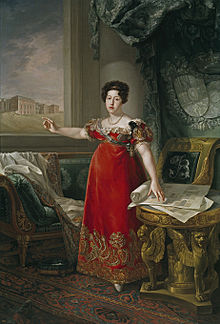
The Spanish royal collection of art was almost entirely built up by the monarchs of the Habsburg family who ruled Spain from 1516 to 1700, and then the Bourbons (1700–1868, with a brief interruption). They included a number of kings with a serious interest in the arts, who were patrons of a series of major artists: Charles V and Philip II were patrons of Titian, Philip IV appointed Velázquez as court painter, and Goya had a similar role at the court of Charles IV.
The royal family were the most important patrons of Spanish art throughout this period, although some important artists including El Greco, Jusepe de Ribera, and Zurbaran were little patronised. Foreign artists were often imported, although even in the 16th century the most successful were often reluctant to go to Spain, partly because they feared they would never be allowed to leave.[1] In addition, at various periods, especially in the 16th and 17th centuries, the monarchs bought paintings abroad on a significant scale, especially in Italy, but also the Spanish Netherlands and France. In early periods the scattered Spanish possessions included the important artistic centres of Milan, Naples, and the Low Countries.

With the loss of the Low Countries as a result of the Peace of Utrecht, the Spanish crown developed tapestry manufacture in Madrid to avoid the need for imports of these luxury items. As a young man, Goya executed a number of tapestry designs for use in the royal palaces. Royal patronage was also used to develop other arts and crafts in Spain in the 18th century, for example the Real Fábrica de Cristales de La Granja produced luxury glass products.
The enormous collections have been significantly reduced by a series of fires, losses in the Napoleonic Wars and to a lesser extent the Spanish Civil War, and diplomatic gifts. The collections have passed to public ownership,[2] and a large number are on display at various locations. Although the collection is rightly most famous for its paintings, with the Prado in Madrid holding the main collection,[3] there are large holdings of sculpture, and most forms of the decorative arts. What is probably the world's finest collection of Renaissance Flemish tapestries is mostly displayed at the Palace of La Granja, and the collection of plate armour in the Armoury in the Royal Palace, Madrid is only rivalled by its equivalent in Vienna.[4]
- ^ Trevor-Roper, 45
- ^ Vanderhoof, Erin (August 2020). "Spain's former king Juan Carlos was never supposed to leave the country". Vanity Fair.
- ^ Prado; collection overview
- ^ Philippe de Montebello, "Introduction", p. 8, in Resplendence of the Spanish Monarchy: Renaissance Tapestries and Armor from the Patrimonio Nacional, by Antonio Domínguez Ortiz, Concha Herrero Carretero, José-A. Godoy, 1991, Metropolitan Museum of Art, ISBN 0870996215, 9780870996214, fully online
© MMXXIII Rich X Search. We shall prevail. All rights reserved. Rich X Search
